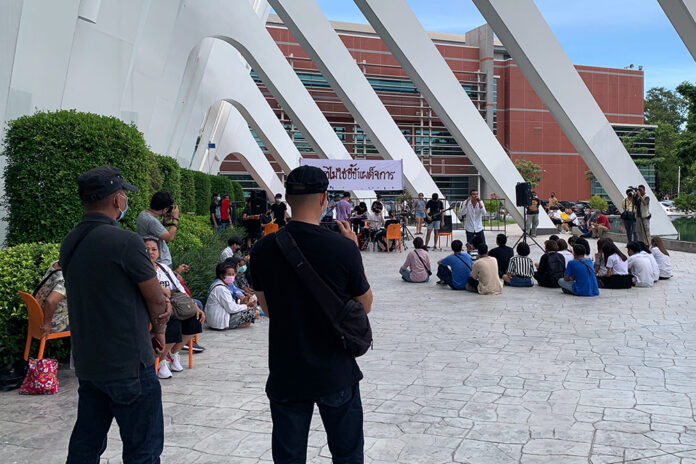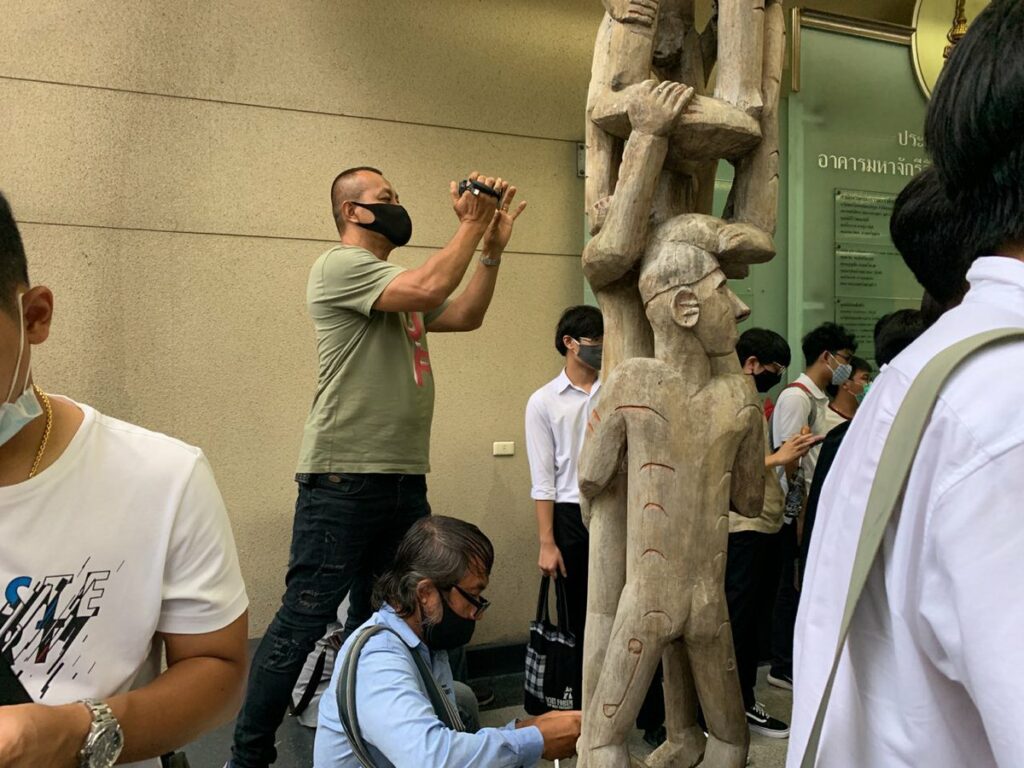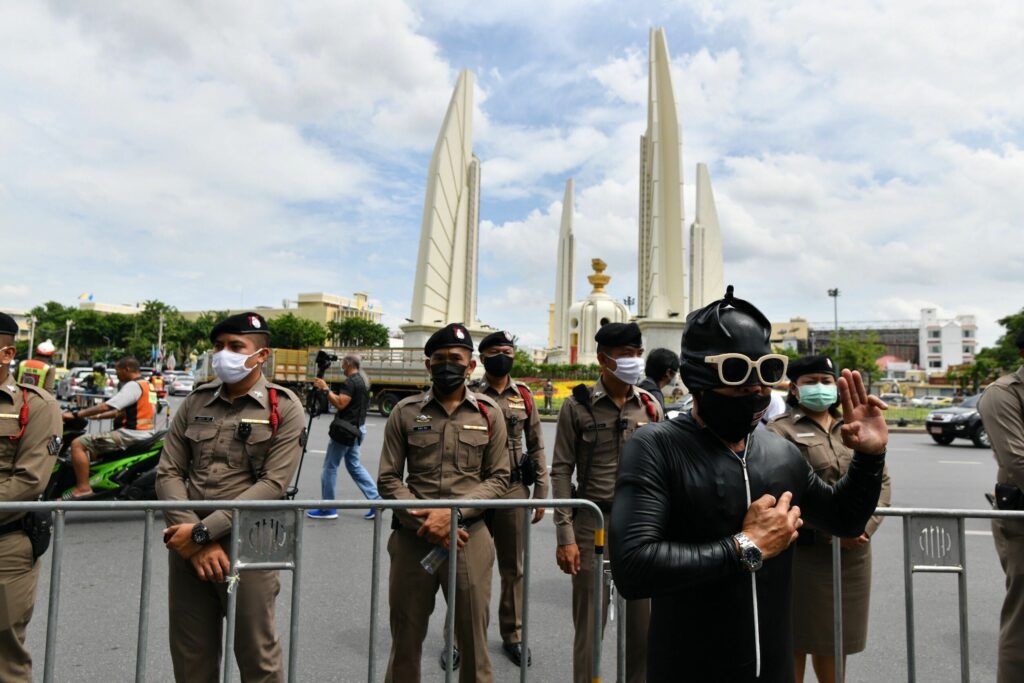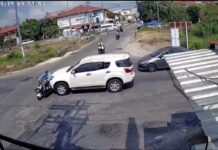
BANGKOK — Just a moment after activist Tattep Ruangprapaikitseree stepped outside his home in Bangkok in late August, he found himself surrounded by several men in crew-cut hair.
Were they thugs paid to hurt him? Just then, a police officer showed up and read out a warrant signed for his arrest. It was then that Tattep realized the men were plain-cloth policemen.
Wednesday’s arrest was one of the recent police operations that rely on undercover police officers. Although a police commander said using plain-cloth policemen is a common practice permitted by the laws, their presence raised alarm among some activists since they cannot distinguish between law enforcement officers from individuals with more sinister intent.
“We use plain-cloth police officers for surveillance and intelligence gathering operations,” Col. Worasak Pisitbannakorn, superintendent of Chana Songkhram Police Station, said in an interview.
Top: A video that purports to show plain-cloth policemen trailing Thammasat University student activists in August 2020.
“The tactic is by the book,” Col. Worasak, whose station often monitors protests, went on. “We usually deploy both uniformed and undercover officers to maintain safety at protest sites, as well as other high-profile events such as international summits.”
The use of plain-cloth officers is so ubiquitous that they are involved in nearly every news article about police arresting criminal suspects. They are also notoriously obvious to spot, thanks to their distinct haircut, polo shirts, dark-colored jeans, and a lack of any attempt to conceal their filming of the protests.
While it is not hard to distinguish demonstrators from police, concerns have been raised over impersonation since many undercover officers do not wear badges when carrying out their duties at protest sites.
Dramatic footage of an anti-government rally in Samut Prakan province on Aug. 21 shows the moment when activist Panusaya Sithijirawattanakul was dragged off the stage by three men clad in black while she was giving an address about the monarchy.
Opposition figures like Pannika Wanich of the Progressive Movement were quick to point their fingers to police. Demonstrators were also preparing to march to a police station and demand answers.
“Plain-cloth police officers stormed the National Labor Assembly stage in an attempt to arrest Panusaya,” Pannika tweeted.
But it was later revealed that the men were in fact private security guards employed by one of the organizers. A standoff with the police was averted at the last minute.
Sowing Distrust?
Although a skirmish similar to last week’s rally is rare in many of the protests over the past months, undercover agents were reportedly seen at almost every single venue.
At a rally at Chulalongkorn University held in August, the Thai Lawyers for Human Rights group counted at least five plain-cloth officers at the event. They could be seen taking photos of the speakers, filming the event, and reporting the situation back to their command via a Line group on their smartphones.
Khaosod English reporters who were providing live coverage on the ground at the protest were also filmed by a man who was believed to be one of the security officials. The man quickly turned his back when a reporter’s camera panned towards him.
Top: Plain-cloth security officers arrest activist Parit Chiwarak on Aug. 14, 2020.
One of the students who helped organize the rally, Sirin Mungcharoen, said she acknowledged the officials’ claim of providing safety at the protest site, but she felt rather insecure with their method.
“I can’t really say that I felt relieved with the police presence,” Sirin said. “I don’t think they intended to provide us security, I think they were there to collect evidence to press charges against us.”
The police presence among the crowd of some 500 people was not totally unknown to the protesters. One of the emcees even said thank you to plain-cloth police officers on stage and told the crowd against interfering with their missions.

Sirin, who has had personal experience of being stalked by a man she believed to be a cop, said she would feel less threatened if police officers wear their uniforms when conducting their duties.
“They shouldn’t hide themselves. It’s better to show off who they’re,” Sirin said.
But Col. Worasak of Chana Songkram Police said citizens have the right to demand the officers to identify themselves under such circumstances.
“Officers are required to present their credentials when asked by citizens,” Worasak said. “We always show our badges or present warrants when we approach an individual.”
He added that it is necessary to go undercover in certain situations to avoid unwanted attention.
“It’s also inappropriate for men in uniform to be seen standing among the protesters,” he said.

Yingcheep Atchanont, a coordinator of legal reform advocate iLaw, also said the tactic of using plain clothes police is an accepted norm and nothing illegal.
“They’re just doing their jobs and it’s perfectly legal,” Yingcheep said. “Uniformed officers maintain security at the outer perimeter and carry out orders under warrants such as making arrests. Undercover officers act as a vigilant sentry inside the rally and gather intelligence.”
“There may be discords between the agents and protesters, but things should be fine if they don’t step on each other’s toes.”
















































